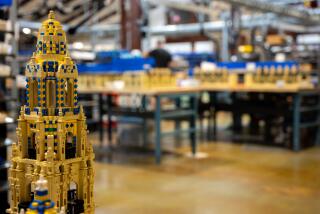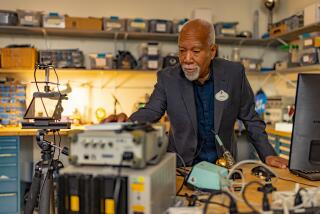Me and my robot
Carlsbad — It’s Robot rush hour. Everywhere you turn, little bug-eyed beings on wheels are noodling down a colorful tabletop course in the Mindstorms building at Legoland.
Hovering over them are their creators, mostly years away from owning legal driver’s licenses, intently monitoring the traffic flow.
The idea behind Mindstorms, as the instructor explains at the start of the 45-minute class, is to give participants a basic understanding of the science behind robotics. The method: Teach them to build and program a creature that will travel to a destination, unload a cargo of colored balls and return to its point of origin.
Amy Hartman, an 11-year-old from Denver, and Jazmin Stubbs, a third-grader from Corona, are quickly finding out that it isn’t quite as simple as it sounds.
Hartman’s robot is throwing balls that are being deflected off its own frame, and Stubbs is watching with a puzzled smile as hers spins in circles without making any forward progress.
This is all part of the learning experience, says Lynn Crockett, Legoland’s education manager. When you bungle the programming, you create an opportunity to sharpen problem-solving skills.
“When kids have a robot that doesn’t work, they’ll grab it, run back to their computers and reprogram it,” Crockett says. “It’s like the scientific method in action. If your hypothesis doesn’t work, you take it back, redo it and bring it back again.”
Before the end of class, both Hartman and Stubbs have figured out their mistakes and returned to the course to launch successful voyages. And Chris Hartman, Amy’s younger brother, has engineered a similarly productive mission, punctuating it with a short celebration.
“We had the robot do a victory dance,” he says with a grin.
The give and take between human and machine -- and the lesson it teaches about attention to detail -- reminds Crockett of her days as a teacher. She’d ask students to show each other how to make a peanut butter sandwich, and they’d say things like, “Oh, you didn’t tell me to pick up the knife.”
“With the robots, it’s the same thing,” she says. “If you don’t tell them to go forward, they’re staying there.”
Since class time is short, Legoland uses robots that follow a few simple commands and require little assembly. Anybody seeking a bigger challenge -- and willing to plunk down $200 -- can pick up Lego’s Robotic Invention System kit, which can be used to build, among other things, candy dispensers, coin sorters and, with accessories, a walking humanoid that snaps photos.
The link between Legos and robotics was established in the mid-1980s when researchers at the Massachusetts Institute of Technology began using Lego bricks for youth education projects. Eventually, Lego and MIT collaborated to produce mobile toys that could obey commands.
Mitchel Resnick, a professor of learning research at the MIT media lab, was in on the ground floor of the Lego-MIT relationship, and he says robot construction -- and its challenges -- is a more valuable educational tool than merely asking kids to answer problems or fill out worksheets.
“It helps them use these concepts in a meaningful context to get a deeper understanding,” he says. “One of the things we’ve found in our research is that many of our best learning experiences come when we’re involved in actively designing and creating things because you get to put your knowledge to work.”
In one workshop Resnick was involved in, a girl built a house for her gerbil with an automatic door that tracked how many times it went in and out. Another girl attached a sensor to her in-line skates to log mileage.
These types of projects reinforce the idea that kids too can be inventors, Resnick says.
“It’s important for them to grow up feeling that they can design things that will make a difference in the world and that the world is not an already-created place that you just get to learn about and that someone else makes,” he says.
As a late afternoon Mindstorms class nears its end, Scott Stubbs, a former computer programmer, expresses similar sentiments while watching his daughters, Jazmin and Crystal, tend to their robots.
“This gets their brains working and gets them to think logically,” he said. “And it’s something physical. It’s not just on the computer screen.”
Plus, he adds, “it takes them away from all the shoot-’em-up type games.”
Don Patterson can be reached at weekend@latimes.com.
*
Mindstorms
Robot Building
What: Classes for ages 10 and up
Where: Legoland-California, One Legoland Drive, Carlsbad
When: Hourly. Until April 18, Legoland is open daily, 10 a.m. to 6 p.m. Starting April 19, it resumes its regular spring schedule: Thursday through Monday, 10 a.m. to 5 p.m., and until 6 p.m. Saturday
Price: Free with admission to the park. Adults, $43.95; children 3 to 12 and seniors 60 and older, $36.95
Info: (760) 918-5300 or www.legoland.com


